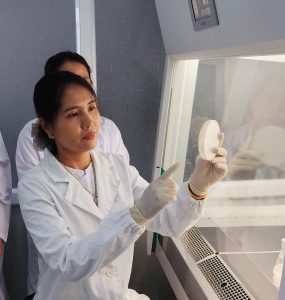Myanmar

Related Research:
“An evaluation into the bio-sorption and biodegradation of azo dyes by indigenous siderophores-producing bacteria immobilized in chitosan” was the topic of my independent research project, which I published in the Springer Biodegradation journal in 2021. This published work was implemented into practice on a full-scale pilot water treatment system in a textile workshop using compactable resources, local inputs, and infrastructure. The full-scale pilot water treatment system has three continuous cement tanks. The three tanks extend 37 feet. It is 3 feet wide and 4 feet high. The first tank collects dyeing room waste. Water is pumped out and flows through a ceramic clay ball developed using natural clay ceramic membrane technology, which adsorbs electrolytes and metal ions and drains into the second tank. The second tank inoculates 13 types of dye-absorbing bacteria isolated from dye contaminated sites. It needs 36–48 hours of aeration depending on the amount of wastewater and dye contents. After liquid-solid separation, wastewater settles for 3–6 hours. The treated effluent can be used for agriculture after the settling water is flow through rice hash char and sand to remove microbial floc and smells. This integrated wastewater treatment system was constructed by using material science and biotechnology based on the aforementioned research findings. The first and final stages used a physical adsorption and absorption method with ceramic clay balls, bio-char, and sand. The second stage of the system applies bio-sorption and biodegradation processes by the action of siderophore-producing microorganisms that were isolated from the textile dye effluent cannel. Anaerobic tanks periodically decompose microbial flocs from second-tank (biological treatment process).
Relation to Climate Resilience and Adaptation Theme:
Inle Lake which is located in a Shan Plateau mountain valley, is an ASEAN Heritage Park and UNESCO Biosphere Reserve. Many endemic fish, snails, and plants reside in its wetland areas. Their lives and customs depend on the lake and its forests. Inle lake is the only source for Lawpita hydropower dam, which supplies 24% of the country’s hydropower. Most villagers are fishermen and farmers, but others manufacture silk, gold, and silver jewelry, and souvenirs. Longterm disposal of toxic chemical dissolved wastewater from local small enterprises like dying silk and cotton and wastewater from households and hotels directly into the lake also affects the lake water quality. The effect of Touristic growth and human induced environmental degradation and climate change, have been addressed to protect Inle Lake’s natural diversity and people’s cultures. The village of Inn Paw Khon in Inle Lake makes silk fabric and cotton fabric and Lotus clothes, which is also the major attraction for tourists from local and international. As the handmade textile sector has grown, its main waste effluent, dyed containing wastewater, has been directly disposed into Inlay Lake, where it impacts the biodiversity of aquatic environment. currently, for the first time, U Than Hlaing’s weaving workshop in Inn Paw Khon Village is being implemented as a model cleaner disposal technique because of this simple and highly effective technology. After a period of six months following the implementation of the system, it led to a notable enhancement in the diversity of aquatic life in the surrounding water bodies of Inle lake. This is evident from the observation that lotus plants, which were previously unable to grow, are now flourishing. Local fish species have also been discovered in the area after disposing treated dye effluent. The majority of environmental degradation in Myanmar cannot be effectively restored due to the weakness of the environmental, social, and governance sectors. Nevertheless, this implementation research has successfully restored ecological inhabitants, and the technology has the potential to adapt and mitigate the climate change of the Inle Lake biosphere.
Affiliated Organisation:
Yangon Technological University, Naypyitaw Technological University
